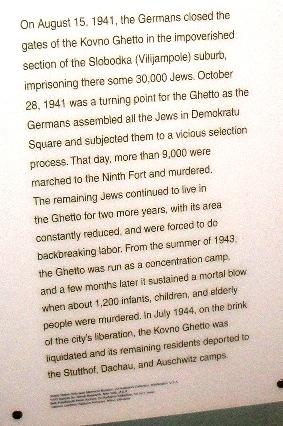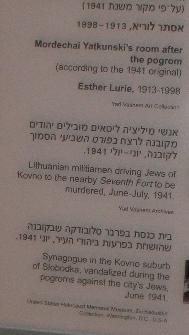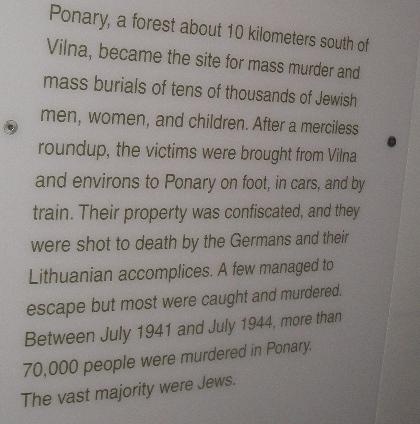D O C U M E N T S
After more than three years’ wait for a substantive reply to the points raised in a letter to Yad Vashem, and in light of the past week’s shocking revalations about political legitimization by Yad Vashem of the Lithuanian government’s “red-brown commission” that is the engine of Prague Declaration and Double Genocide politics in Europe, DefendingHistory is releasing the full text of the letter of 28 June 2009, and the initial reply received the following day.
In the original the images, numbered 1-7, were included as email attachments. Here they are inserted in the text. [Note: the author’s eleven-year Vilnius University affiliation ended in 2010.]
—-Original Message—–
From: Dovid Katz [mailto:dovidkatz@vilniusuniversity.net]
Sent: Sunday, June 28, 2009 1:17 PM
To: גביר יוסי
Cc: ‘Simon Wiesenthal Center-Israel Office’; ‘Dov Levin’; ‘Joseph Melamed’
Subject: from Dovid Katz (Vilnius University)
Greetings dear Yossi (at the moment from Tel Aviv),
Trust this finds you and all at Yad Vashem well and thriving. As you may recall, we corresponded for several months in Spring 2008. I had been (and frankly remain) disappointed that by continuing to allow Yad Vashem’s name to appear as a partner of the Lithuanian government sponsored “Red-Brown Commission” even as the falsification of history (replacement of the very notion of the Holocaust by a paradigm of two equal genocides) continues apace at the European Parliament. Parliamentarians are told: “Look, Yad Vashem is with us….” Of course Yad Vashem has no such intention, and we are in agreement that it’s important for Lithuanian teachers to be educated in Jerusalem but that should be facilitated through any of the various honest NGOs or educators, not the “Red-Brown Commission” whose major current project is passage of the “equal genocide” resolutions in the European Parliament. My two recent op-eds on the topic are in the Jewish Chronicle and Irish Times.
There are dozens of internet mentions of the Commission’s central work in persuading the European Union and Parliament to adopt the revisionist historical model (I’d once sent you a list, one of many examples at: http://www.komisija.lt/en/naujiena.php?id=1215150457). There are constant complaints about Holocaust survivors being “favored” over Communist victims…
Moreover, to this day the Commission has not publicly condemned, in Lithuania or abroad, the ongoing media campaign against resistance heroes Yitzhak Arad, Fania Brantsovsky and Rachel Margolis. (I came to Israel this time to honor Rachel, last week at a ceremony in Tel Aviv, at Leivick House, chaired by its director Daniel Galay, and attended by Israeli ambassador to the Baltics Chen Ivri Apter; I also had the honor of speaking on the Lithuanian Holocaust issues last Tuesday at the Jerusalem Center for Public Affairs.) That private letter once sent to Yad Vashem by the Commission’s chairman is completely at variance with what they have been saying and not saying in Lithuanian. In the absence of public condemnation by the Red-Brown Commission of the calumny against Yitzhak Arad, Yad Vashem’s former director for a period of more than twenty years, such private letters have no significance in Europe.
On a related topic:
I visited Yad Vashem on Thursday, my first visit in many years. Warmest congratulations on the incredible overhaul and the magnificent historical presentation starting with the history of antisemitism.
On the subject of Lithuania and the Baltics more generally, it seemed to me, however, that there is some reluctance to make clear that murders of (and serious violence against) Jewish civilians broke out in numerous locations from 22 June 1941 onward in many locations before the Germans took control (at different dates in different locations). This discrepancy is particularly evident in image no. 1 (see attached) which seems to cover for the well documented pre German arrival Kaunas (Kovno) mass murders of June 23rd and June 24th.

1
Other exhibits fail to make clear that local Lithuanian nationalists not only “led” the Jews to murder but constituted the majority of the murderers at each of the locations covered (see images 2-6).

2
◊

3
◊

4
◊

5
◊

6
Finally, the sensational rediscovery of Sakowicz’s diary (thanks to Rachel Margolis, now in Rechovot, and unable to return to Vilnius….) is so important because this Polish Christian recorded that it was Lithuanian volunteers at Ponar who did most of the actual killing. Perhaps I missed something (it’s not possible to see everything in one visit of course), but the Sakowicz text (see image no. 7) seems to miss this point: his eyewitness testimony confirms who the vast majority of the murderers were there. All in all, the onset of mass murder in the Baltics in 1941, with locals doing most of the actual killing, is not as clear as it might be.

7
A curiosity: One of the NGOs that would be a reliable partner for choosing sincere teachers for trips to Jerusalem would be the House of Memory, founded by Linas Vildžiūnas. Many years ago, I interviewed him and asked him what motivated him in the first place. He told me it was his visit to Yad Vashem in the early 1990s, when he saw images of Lithuanian “nationalist heroes with white arm bands” attacking Jewish neighbors even before the Germans arrived. The irony is that I don’t think he’d see that today, but again, sincerest apologies if I’ve missed something important on the topic.
All good wishes, and apologies for all the uninvited comments!
Cheers and a gute vokh
Dovid
Professor Dovid Katz
Research Director, Vilnius Yiddish Institute
Professor of Yiddish Language, Literature and Culture, Vilnius University
www.dovidkatz.net
From: yossi.gevir@yadvashem.org.il [mailto:yossi.gevir@yadvashem.org.il]
Sent: Monday, June 29, 2009 3:53 PM
To: dovidkatz@vilniusuniversity.net
Subject: From Yossi Gevir
Dear Dovid,
Thanks for your letter, which I’ve read carefully. We’re looking into the points that you’ve raised. I’ll get back to you ASAP.
Best wishes,
Yossi